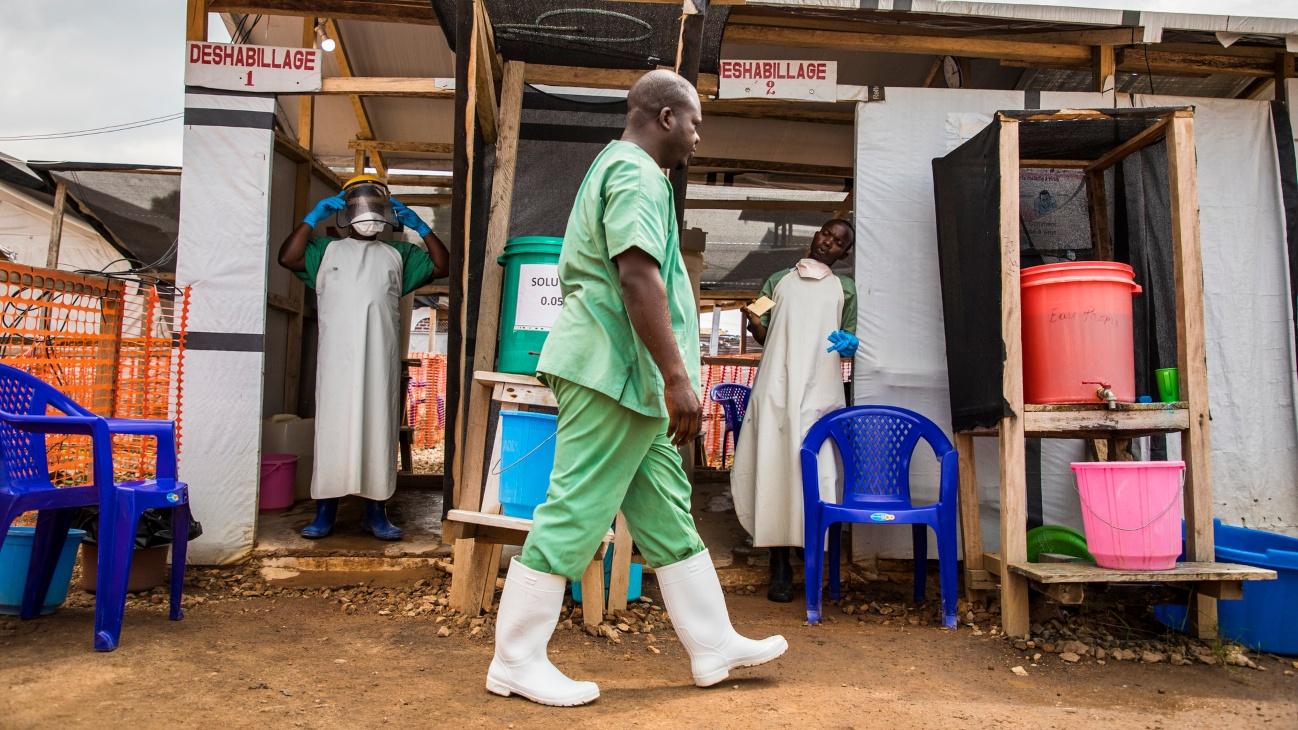LSE alumnus Waiswa Nkwanga argues that the World Bank and IMF must shoulder some of the blame for the poor health infrastructure in many African countries.
As the dramatic Ebola media frenzy wears off, we should not let the problems it has exposed go unexplained. The Ebola crisis lays bare the crux of the matter regarding the pathetic state of healthcare systems in the countries most affected by the epidemic and, by implication, in sub-Saharan Africa as a whole. We need answers as to how things got so bad in the first place.
Before the Ebola crisis in West Africa caught the world by surprise by threatening lives outside of Africa for the first time since the discovery of the virus in 1976, international donors had been busy playing the healthcare card to showcase the miracles their interventions were making in Africa. All sorts of figures were thrown around to show just how profound and unprecedented their impact had been. Just last year, in a World Health Organisation (WHO) report, Liberia was named among the top six countries that made the greatest progress in healthcare in the world —having increased life expectancy by 19.7 years.

However, as the Ebola epidemic spun out of control in Liberia, analysts, policymakers and donors seemed shocked at the state of the country’s healthcare infrastructure and the way in which the epidemic rendered the small West African country – and the international community – completely helpless. One could not help but wonder what kind of progress donors had really been talking about all along.
To be sure, donors are not lying when they say healthcare has improved in African countries as a result of their interventions over the past decade or so. After all, across the continent life expectancy has increased from 50 years in 1990 to 58 years by 2012; infant and child mortality has declined, and more people have access to potable drinking water —among other things. Where they go wrong is in claiming that these interventions represent structural change to the overall strength of the healthcare infrastructure in Africa.
Just as high GDP growth is not the same thing as development and could have little or no bearing on, say, improvements to standards of living for the majority of the people in a given country– as is currently the case in most of Africa – to a certain point, longer life expectancy, for example, may have little connection to the quality of health care available in a country or the presence of an adequate professional health care workforce.
Indeed, a fundamental paradox underlying recent achievements in health care in Africa has been the apparent disconnect between short-term, life-saving interventions on the one hand and deteriorating healthcare infrastructure on the other. Simply put, while donors have undoubtedly saved many lives in Africa in the short term, not enough efforts have been made to build the infrastructure that is necessary to sustain them over the long term.
So who is responsible for the breakdown of healthcare systems in Africa in the first place?
As always, the first suspect is the unethical, corrupt African leaders who plunder their countries and stop at nothing to pilfer donor funds. They are entirely to blame for the underinvestment in and the near total breakdown of the healthcare system in Africa. Pervasive corruption has indeed suffocated development in many African countries, but it is only a small part of the problem.
Uganda, in particular, is instructive here not least because it has a number of characteristics in common with countries like Liberia and Sierra Leone, in that all three countries experienced prolonged, economically devastating, bloody civil wars. In addition, there is more corruption in Uganda than Liberia and Sierra Leone. According to last year’s Corruption Perceptions Indexes by Transparency International, Uganda ranked 142 out of 175 countries globally in corruption compared with Liberia and Sierra Leone at 94 and 119 respectively. In fact, Uganda is one of the countries in Africa wherein recent years government officials have embezzled millions of international funds – including the Global Fund meant to fight Aids, tuberculosis and malaria as well as the Global Alliance for Vaccines and Immunisation (Gavi).
Yet Uganda has successfully dealt with several Ebola outbreaks in the past and currently has one – if not the most – robust Ebola response programmes on the continent and arguably in the world.
At this point, it is clear that Africa’s enduring healthcare problem—of which the Ebola epidemic is just a symptom—is broader and deeper. It is not simply the creation of corrupt governments, as commonly suggested, although that is part of the problem. It is also the work of international institutions, particularly the World Bank and the International Monetary Fund (IMF), that introduced certain policies, the Structural Adjustment Policies (SAPs), in developing countries, which at least in the case of Africa resulted in underinvestment in healthcare systems.
The story begins with a rather notable study by the World Bank, commonly referred to as the Berg report. Published in 1981, in response to the global debt crisis of the late 1970s and the economic distress it had exerted on poor countries, the document became a blueprint for the Bank’s approach to the continent for decades to come.
The study placed all the blame squarely on excessive government spending on social programmes, including healthcare. Accordingly, despite acknowledging that in many African countries, hospitals, clinics, and equipment had “fallen into disrepair” with facilities often “staffed at levels far below what is needed,” the Bank proceeded to advocate deep cuts in public spending on healthcare services, including health infrastructure.
As a result, following the introduction of SAPs, government expenditure as a percentage of GDP on health plunged. Between 1980 and 1987, for example, real per capita government spending on healthcare in Africa fell by forty-two percent. The point comes into sharper focus when we look at African government expenditures on healthcare over the past thirty years. According to the Berg Report, in 1979, government expenditure on health as percentage of GDP in Africa averaged between five to seven percent. A recent study by the WHO shows the rate at between 5.6 to 6.2 percent.
Today, the physician-to-patient ratio in Africa hovers at 2 per 10,000 of the population, and nurses and midwives-to-patient at 12 per 10,000, with minor variations among countries, according to the World Bank and the World Health Organisation. That ratio is less than 1 physician per 10,000 people in Liberia, less than 2 in Uganda, and about 4 in Nigeria—the second highest in the region after South Africa, with seven physicians per 10,000 population. Never mind the deteriorating physical infrastructure in the form of hospitals and technology across the continent.
These rates are extremely low even when compared to other developing countries in other parts of the world. (For example, Mexico has 21 physicians per 10,000 of the population, while China has 15 doctors for every 10,000 people.)
Indeed the failure of SAPs led to the introduction of the Millennium Development Goals (MDGs) in 2000 to help curb rising poverty, disease, illiteracy and so on. The MDGs will expire in 2015. By any plausible account, they too have failed to cure the underlying structural problems facing African development, including health care systems, despite some notable achievements.
It is worth noting that at the height the Ebola crisis in West Africa some World Bank and IMF officials seemed to acknowledge their past mistakes, albeit only implicitly. Speaking at a special session with African leaders on Ebola in Washington D.C. last October, the Managing Director of the IMF, Christine Lagarde, said, “It is very rare to say that, but on this occasion I will say it: It is good to increase the fiscal deficit when it’s a matter of curing the people.” Then, with a visibly stern look of frustration on her face, turned her head, looked straight into the camera, and repeated, “It is good to increase the fiscal deficit… the IMF doesn’t say that very much.”
That is encouraging, but whether it will translate into a concrete policy shift by these institutions going forward remains unknown. What we do know is that discussions are already under way in Western capitals on what will replace the MDGs. Hopefully this time around those who have taken it upon themselves to decide the future of the world’s poor—bearing in mind both institutions are a big part of this—will be modest enough to acknowledge the past failures of their policies before imposing new ones.
Hopefully they will be smart enough to realise that health crises such as Ebola are merely symptoms of a much deeper structural problem that needs urgent attention, and that short-term, life-saving emergency interventions are not enough to remedy the problem. These measures are akin to scooping water out of leaking ship — it can keep one afloat in the short term, but eventually the ship sinks. That’s the lesson that the Ebola crisis in West Africa teaches us.
Above all, hopefully those who have taken it upon themselves to decide the future of the world’s poor will listen to African voices this time. As Atul Gawande of The New Yorker points out in the article “Slow Ideas”: “Every change requires effort, and the decision to make that effort is a social process.” This is even more so in Africa where most people live in small, traditional communities in rural areas with limited access to modern amenities. We know, for example, that in the late 1980s through the 90s—at the height of the HIV/Aids crisis in Africa—Uganda once again successfully reduced HIV/Aids prevalence rates from 18 percent to 6.1, with little in the way of a healthcare system or international aid and before ARVs were available in most of Africa. The Ugandan government relied entirely on social structures and word of mouth to educate its citizens about the then urgent threat of HIV/AIDS. Unfortunately, that has not been the case in recent interventions in Africa as evidenced by the SAPs that were implemented at gunpoint in some African countries.
Waiswa Nkwanga is a LSE alumnus.
The views expressed in this post are those of the author and in no way reflect those of the Africa at LSE blog or the London School of Economics and Political Science.






You can spot weak analysis in absolutes:
“They are entirely to blame for the underinvestment in and the near total breakdown of the healthcare system in Africa.”
and then…
“It is not simply the creation of corrupt governments, as commonly suggested, although that is part of the problem”
Even if IMF and WB are to blame, weak writing undermines the argument.
Are there any sources for this article?